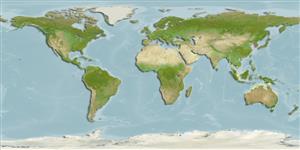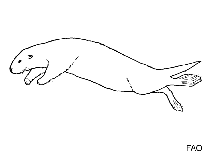Lutra lutra (Linnaeus, 1758)
Eurasian river otter| Native range | All suitable habitat | Point map | Year 2050 |

|
| This map was computer-generated and has not yet been reviewed. |
| Lutra lutra AquaMaps Data sources: GBIF OBIS |
Google image | No image available for this species;
drawing shows typical species in Mustelidae.
Classification / Names Common names | Synonyms | CoL | ITIS | WoRMS
Mammalia | Carnivora | Mustelidae
Environment: milieu / climate zone / depth range / distribution range Ecology
Pelagic; freshwater. Tropical
Distribution Countries | FAO areas | Ecosystems | Occurrences | Introductions
Asia and Europe Inland Waters, Northeast Atlantic; Indo-West Pacific, and the Mediterranean: Lutra lutra lutra: Ireland, Great Britain, Maghrib, continental Eurasia from Scandinavia and the Iberian Peninsula east to Kamchatka and Manchuria, Sakhalin, Kuril Island; Lutra lutra meridionalis: Turkey, southern Caucasus, Israel, Syria, Iraq, Iran; Lutra lutra seistanica: southern Turkmeniya, Iran, Uzbekistan, Afghanistan, and southern Kazakhstan, Xinjiang; Lutra lutra kutab: Pakistan, Tibet; Lutra lutra monticola: India, Nepal; Lutra lutra aurobrunnea: India, Nepal; Lutra lutra chinensis: China, Indochina, Thailand, Malaysia, Vietnam, Ryukyu, Taiwan; Lutra lutra nair: India, Sri Lanka; Lutra lutra hainana: Hainan, China; Lutra lutra whiteleyi: Hokkaido, Japan; Lutra lutra sumatrana: Southern Vietnam, peninsular Malaysia, Singapore, Indonesia (Ref. 1522).
Length at first maturity / Size / Weight / Age
Maturity: Lm ? range ? - ? cm Max length : 980 cm TL male/unsexed; (Ref. 1005); 1070 cm TL (female); max. published weight: 10.0 t (Ref. 1005)
Life cycle and mating behavior Maturity | Reproduction | Spawning | Eggs | Fecundity | Larvae
Main reference
References | Coordinator | Collaborators
Rice, D.W. 1998 Marine Mammals of the World Systematics and Distribution. Special Publication number 4: The Society for Marine Mammalogy. 231p. (Ref. 1522)
IUCN Red List Status
(Ref. 130435: Version 2025-1)
CITES status (Ref. 108899)
CMS (Ref. 116361)
Threat to humans
Human uses
| FishSource |
Tools
More information
Max. ages / sizes
Length-weight rel.
Length-length rel.
Length-frequencies
Mass conversion
Abundance
Maturity
Fecundity
Spawning
Eggs
Egg development
Larvae
Internet sources
BHL | BOLD Systems | CISTI | DiscoverLife | FAO(Publication : search) | Fishipedia | GenBank (genome, nucleotide) | GloBI | Gomexsi | Google Books | Google Scholar | Google | PubMed | Tree of Life | Wikipedia (Go, Search) | Zoological Record



